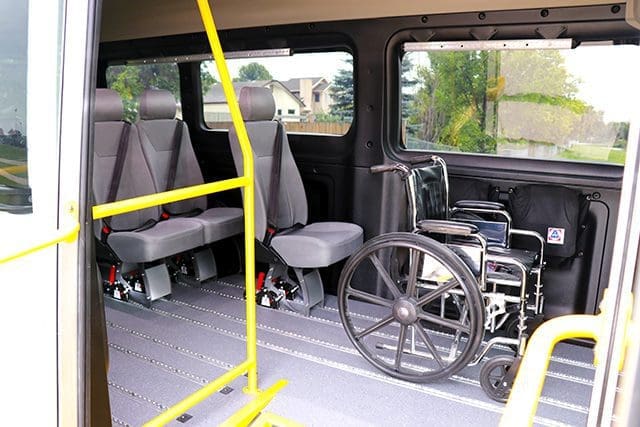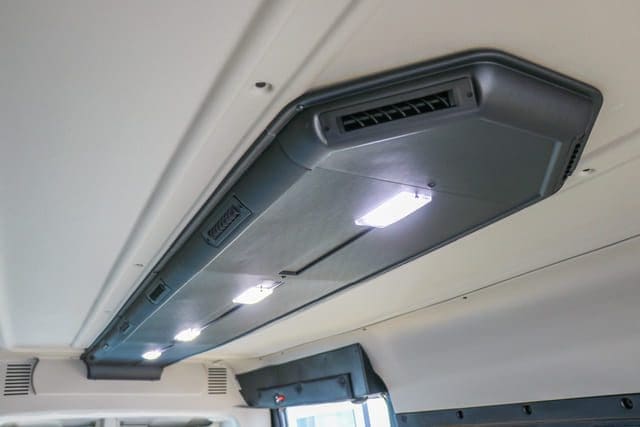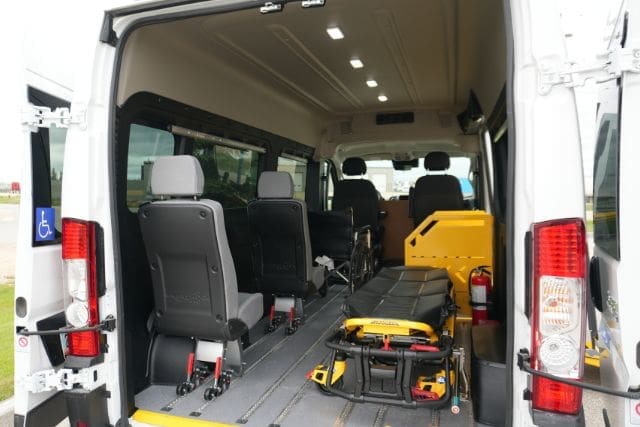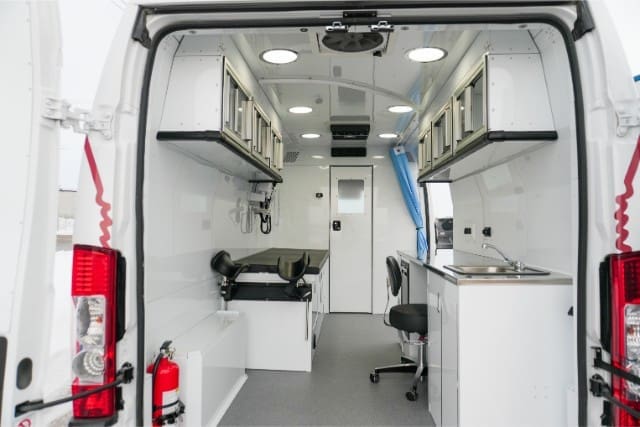Is your organization confused about what wheelchair van heating and cooling systems to get for your future wheelchair van in Canada? Choosing the wrong heating and cooling system can result in uneven heating and cooling throughout the van. This can cause certain areas of the van to feel warmer or cooler than others, leading to discomfort for your clients. Exposure to the cold can also cause things like:
- Irritated airways
- Difficulty breathing
- Increased risk of respiratory infection
Exposure to heat can lead to:
- Dehydration
- Increased stress
- More fatigue
At MoveMobility, we manufacture wheelchair vans and know how important it is to keep your clients comfortable in the vehicle. That’s why we offer both a standard heat and cooling system and a high-capacity one so that your clients’ experience will be the best that it can be.
In this article, you’ll learn more about:
- The two wheelchair van heating and cooling systems
- Benefits of each system
- Limitations of the standard system
- Drawbacks of the high-capacity system
What is the standard heating and cooling system in wheelchair vans?
The standard original equipment manufacturer (OEM) heating and cooling system is the one that comes already installed in a wheelchair van. It’s made by the original manufacturers, and its job is to keep the entire van climate-controlled.
Benefits of the standard wheelchair van heating and cooling systems
Having a standard OEM heating and cooling system in a wheelchair van in Canada is great for a few reasons.
Integration: When the van is being made, the standard OEM system is installed in a way that blends in perfectly. You don’t have to worry about any extra changes or modifications to make it fit.
Control: You can control the temperature and airflow with dials on the dashboard, making it easy to adjust to your liking.
Reliability: The standard OEM heating and cooling system is made specifically for your van model. That means it’s built to fit and work perfectly with your van, so you can have confidence in its reliability and performance.
Drawbacks of the standard wheelchair van heating and cooling systems
Although the standard heating and cooling system in wheelchair vans has its benefits, there are a few things to keep in mind where it might not work as well. Let’s take a closer look.
Troubles in bigger vans: The standard heating and cooling system is usually good for smaller vans, such as a Side Entry Chrysler Grand Caravan but in larger vans like the P6 Accessible Van, it can have some difficulties. If the van has been sitting outside in the middle of a Winnipeg winter, the standard heat system will take a bit longer to warm it up, ranging between 15 and 30 minutes.
Cold drafts: If you’re opening and closing the van doors often when you’re picking up or dropping off clients, the standard system will have a tough time keeping up. Every time the door opens, the warm air escapes, and the system has to work harder to keep the van warm.
What is the high-capacity heating and cooling system?

In some cases, the standard heating and cooling system in a wheelchair van may not provide enough warmth to keep the entire vehicle comfortable, especially during colder weather. That’s where the high-capacity system comes into the picture. The same goes for the hot, summer months of the year where you need a cooling system to keep your clients comfortable.
A high-capacity heating and cooling system, like the one offered by us at MoveMobility, is designed to work with the standard system. It acts as a secondary system for the wheelchair van and is controlled by dials near the driver.
What are the benefits of the high-capacity heating and cooling system in wheelchair vans?
The high-capacity heating and cooling system is a real game-changer when it comes to keeping your clients cozy and comfortable in a wheelchair van. Let’s look at this system’s details and how it makes a difference.
Better heating and cooling distribution
With the high-capacity system, warm and cool air spread more evenly throughout the entire van. That means everyone, from the front to the back, gets to enjoy warmth in the winter and coolness in the summer. There are air vents all the way to the back of the vehicle on both sides of the van. That means the windows are less likely to fog up in the winter and defrost quicker.
Personal air vents for passengers
You’re outside on a cool day, maybe during fall or winter, and you’re about to take a ride in a car. As you open the door and climb into the backseat, you can feel the cold air surrounding you. The seats might be a bit chilly, and you might shiver a little as you settle in.
With the high-capacity system, passengers in the back get their own air vents. These dedicated air vents allow them to control the airflow and feel the warmth directly. It’s like having a personal heater at your fingertips.
Faster warming up and cooling down
Nobody likes waiting forever for the van to warm up in cold Canadian winters. That’s where the high-capacity heat system shines. It can warm the vehicle in as little as 5 minutes, compared to 15 – 30 minutes with the standard system. On the flip side, your clients won’t have to deal with the discomfort of a hot van.
Considerations for a high-capacity heating and cooling system
As long as the high-capacity heating and cooling system is specified in the original build plans, no further modifications are required to make it work. On the other hand, if you decide you want to upgrade to a high-capacity system after the van is already built, that can be a challenge for a few reasons:
- Wheelchair vans have limited space
- High-capacity systems require structural changes
- The electrical system requires an upgrade to handle the increased load
It’s not as simple as adding the system later on. If your program or organization is in the market for a new wheelchair van, it’s important to plan ahead and inform the manufacturer of the necessary specifications and requirements before the van is initially built. Let’s take a look at some other things to consider when installing a high-capacity heating and cooling system in wheelchair vans.
Space requirements
A high-capacity heat and cooling system takes up more space in a wheelchair van compared to the standard system. In certain wheelchair van models, like the 136WB, a high-capacity system affects the seating. Because the system is located in the back corner, it limits the back row of the vehicle to three seats instead of four because it takes up its own spot.
Cost
The high-capacity heating and cooling system is about twice the cost of a standard system. This is because it offers more heating and cooling power and performance. Even though the high-capacity system is more expensive upfront, the ongoing running costs are the same as those of a standard system.
Deciding on a heating and cooling system for your wheelchair van
There are a few things to think about when making a decision on a heating and cooling system for your wheelchair van.
Budget: Consider your budget and if you can afford the higher initial cost of the high-capacity system. Decide if the extra heating and cooling power is worth the additional expense for your needs.
Heating and cooling needs: At MoveMobility, we don’t want you or your clients to feel cold in the winter or too warm in the summer. That’s why we highly recommend the high-capacity heating and cooling system, especially for customers in cold, prairie regions.
Consult with experts: Before deciding between the standard or high-capacity system, it’s a good idea to talk to the manufacturer who knows about wheelchair van upgrades. They can give you personalized advice based on what you need. They’ll consider factors like your climate, how often you open and close the van doors, and other important factors.
Choosing the right wheelchair van heating and cooling options in Canada
You came to this article feeling confused about wheelchair van heating and cooling options in Canada. Now you know that there are two options to choose from and that it’s important to pick the one that will keep your clients comfortable.
Picking the wrong heating and cooling system for your organization’s wheelchair van can make you feel really uncomfortable during trips. It might get too hot or too cold, and that can be tough and upsetting for you and your clients. It’s important to find the right solution, so you feel nice and comfy while traveling.
At MoveMobility, we fully understand the importance of client comfort in wheelchair vans. To choose the right heating and cooling system, consider your budget and heating and cooling needs, and consider contacting us with any questions you have.
If you’re looking for more information on wheelchair vans, take a read through these articles:








